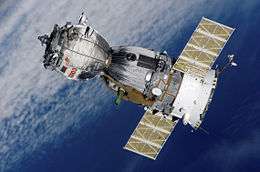Soyuz 39
| COSPAR ID | 1981-029A[1] | ||||
|---|---|---|---|---|---|
| SATCAT № | 12366[1] | ||||
| Mission duration | 7 days, 20 hours, 42 minutes, 3 seconds | ||||
| Orbits completed | 124 | ||||
| Spacecraft properties | |||||
| Spacecraft type | Soyuz 7K-T | ||||
| Manufacturer | NPO Energia | ||||
| Launch mass | 6,800 kilograms (15,000 lb) | ||||
| Crew | |||||
| Crew size | 2 | ||||
| Members |
Vladimir Dzhanibekov Jügderdemidiin Gürragchaa | ||||
| Callsign | Pamir (Pamirs) | ||||
| Start of mission | |||||
| Launch date | 22 March 1981, 14:58:55 UTC | ||||
| Rocket | Soyuz-U | ||||
| Launch site | Baikonur 1/5 | ||||
| End of mission | |||||
| Landing date | 30 March 1981, 11:40:58 UTC | ||||
| Landing site | 175 km SE of Dzhezkazgan | ||||
| Orbital parameters | |||||
| Reference system | Geocentric | ||||
| Regime | Low Earth | ||||
| Perigee | 197.5 kilometres (122.7 mi) | ||||
| Apogee | 282.8 kilometres (175.7 mi) | ||||
| Inclination | 51.6 degrees | ||||
| Period | 89.1 minutes | ||||
| Docking with Salyut 6 | |||||

| |||||
Soyuz 39 was a 1981 Soviet manned space flight to the Salyut 6 space station. It was the fifteenth expedition, and carried the eighth international crew to the orbiting facility.[2] The crew visited Vladimir Kovalyonok and Viktor Savinykh, who had reached Salyut-6 ten days prior.
The flight carried Vladimir Dzhanibekov and Jügderdemidiin Gürragchaa into space. With this mission, Gürragchaa became the first Mongolian, and second Asian cosmonaut.
The Mongolian contribution for this mission had begun in 1967, when the president of the Mongolian Academy of Sciences Bazaryn Shirendev attended a conference of scientists from socialist countries in Moscow, where the Intercosmos project was announced.[3] Dzhanibekov and Gürragchaa performed about thirty experiments during the course of the mission.[4]
Crew
| Position | Crew | |
|---|---|---|
| Commander | Vladimir Dzhanibekov Second spaceflight | |
| Research Cosmonaut | Jügderdemidiin Gürragchaa First spaceflight | |
Backup crew
| Position | Crew | |
|---|---|---|
| Commander | Vladimir Lyakhov | |
| Research Cosmonaut | Maidarjavyn Ganzorig | |
Mission parameters
- Mass: 6800 kg
- Perigee: 197.5 km
- Apogee: 282.8 km
- Inclination: 51.6°
- Period: 89.01 minutes
Mission highlights

Soyuz 39 docked with the first Mongolian cosmonaut aboard. The resident EO-6 crew assisted the Intercosmos crew with station equipment and oriented the station according to the needs of the visiting crew's experiments.
On 24 March, the cosmonauts installed cosmic ray detectors in the station's work and transfer compartments. On 26 March the cosmonauts performed the Illuminator ("viewing port") experiment, which studied the degradation of the station’s viewports. On 27 March, Vladimir Kovalyonok and Viktor Savinykh of the resident crew used the Gologramma ("hologram") apparatus to image a viewing port damaged by micrometeoroids. They repeated this experiment the next day, when they also collected samples of the station’s air and microflora and removed the cosmic ray detectors for return to Earth. 28-29 March were largely devoted to studies of Mongolia from space. The visiting crew also checked out their spacecraft on 29 March
The Soviet news service TASS noted that by 29 March, Salyut 6 had conducted 20,140 revolutions of Earth.
References
- 1 2 McDowell, Jonathan. "SATCAT". Jonathan's Space Pages. Retrieved 24 March 2014.
- ↑ The mission report is available here: http://www.spacefacts.de/mission/english/soyuz-39.htm
- ↑ "Сансрын хамтарсан нислэг". Retrieved 21 March 2012.
- ↑ "Зөвлөлт-монголын сансрын хамтарсан нислэгийн үеэр хийсэн эрдэм шинжилгээний сорил, туршилтууд". Retrieved 21 March 2012.

